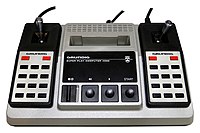
The Atari 5200 SuperSystem or simply Atari 5200 is a home video game console introduced in 1982 by Atari, Inc. as a higher-end complement for the popular Atari Video Computer System. The VCS was renamed to the Atari 2600 at the time of the 5200's launch. Created to compete with Mattel's Intellivision, the 5200 wound up a direct competitor of ColecoVision shortly after its release. While the Coleco system shipped with the first home version of Nintendo's Donkey Kong, the 5200 included the 1978 arcade game Super Breakout which had already appeared on the Atari 8-bit computers and Atari VCS in 1979 and 1981 respectively.

The Atari 7800 ProSystem, or simply the Atari 7800, is a home video game console officially released by Atari Corporation in 1986 as the successor to both the Atari 2600 and Atari 5200. It can run almost all Atari 2600 cartridges, making it one of the first consoles with backward compatibility. It shipped with a different model of joystick from the 2600-standard CX40 and Pole Position II as the pack-in game. Most of the announced titles at launch were ports of 1981–1983 arcade video games.
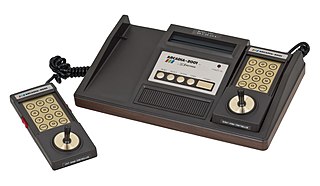
The Arcadia 2001 is a second-generation 8-bit home video game console released by Emerson Radio in May 1982 for a price of US$ 99, several months before the release of ColecoVision. It was discontinued only 18 months later, with a total of 35 games having been released. Emerson licensed the Arcadia 2001 to Bandai, which released it in Japan. Over 30 Arcadia 2001 clones exist.

The Commodore 64, also known as the C64, is an 8-bit home computer introduced in January 1982 by Commodore International. It has been listed in the Guinness World Records as the highest-selling single computer model of all time, with independent estimates placing the number sold between 12.5 and 17 million units. Volume production started in early 1982, marketing in August for US$595. Preceded by the VIC-20 and Commodore PET, the C64 took its name from its 64 kilobytes(65,536 bytes) of RAM. With support for multicolor sprites and a custom chip for waveform generation, the C64 could create superior visuals and audio compared to systems without such custom hardware.

ColecoVision is a second-generation home video-game console developed by Coleco and launched in North America in August 1982. It was released a year later in Europe by CBS Electronics as the CBS ColecoVision.

The Fairchild Channel F, short for "Channel Fun", is a video game console, the first to be based on a microprocessor and to use ROM cartridges instead of having games built-in. It was released by Fairchild Camera and Instrument in November 1976 across North America at a retail price of US$169.95. It was launched as the "Video Entertainment System", but when Atari released its Video Computer System the next year, Fairchild rebranded their machine as "Channel F" while keeping the Video Entertainment System descriptor.
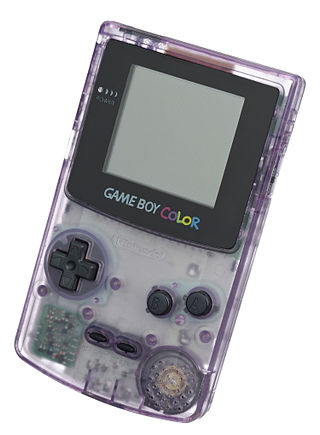
The Game Boy Color is an 8-bit handheld game console, manufactured by Nintendo, which was released in Japan on October 21, 1998 and to international markets that November. It is the successor to the Game Boy and is part of its product line. Critics like IGN consider it more akin to a hardware revision than a next generation product.

The Intellivision is a home video game console released by Mattel Electronics in 1979. The name is a portmanteau of "intelligent television". Development began in 1977, the same year as the launch of its main competitor, the Atari 2600. In 1984, Mattel sold its video game assets to a former Mattel Electronics executive and investors, eventually becoming INTV Corporation. Game development ran from 1978 to 1990, when the Intellivision was discontinued. From 1980 to 1983, more than 3.75 million consoles were sold. As per Intellivision Entertainment the final tally through 1990 is somewhere between 4.5 and 5 million consoles sold.

The Neo Geo, stylized as NEO•GEO and also written as NEOGEO, is a ROM cartridge-based arcade system board and fourth-generation home video game console released on April 26, 1990, by Japanese game company SNK Corporation. It was the first system in SNK's Neo Geo family.

The Neo Geo CD is the second home video game console of SNK Corporation's Neo Geo family, released on September 9, 1994, four years after its cartridge-based equivalent. This is the same platform, converted to the cheaper CD format retailing at $49 to 79 per title, compared to the $300 cartridges. The system was originally priced at US$399, or £399. The system can also play Audio CDs. All three versions of the system have no region lock, but they are region aware, and some games will display English or Japanese depending on the console's region setting. The Neo Geo CD was launched with a bundled control pad instead of a joystick like the AES version. A newly designed joystick was released alongside the Neo Geo CD, and the system was compatible with controllers from the AES.

The Magnavox Odyssey 2, also known as Philips Odyssey 2, is a second generation home video game console that was released in 1978. It was sold in Europe as the Philips Videopac G7000, in Brazil and Peru as the Philips Odyssey and in Japan as Odyssey2. The Odyssey 2 was one of the five major home consoles prior to the 1983 video game market crash, along with Atari 2600, Atari 5200, Intellivision and ColecoVision.

The FM Towns is a Japanese personal computer built by Fujitsu from February 1989 to the summer of 1997. It started as a proprietary PC variant intended for multimedia applications and PC games, but later became more compatible with IBM PC compatibles. In 1993, the FM Towns Marty was released, a game console compatible with existing FM Towns games.

The PC Engine SuperGrafx, also known as simply the SuperGrafx, is a fourth-generation home video game console manufactured by NEC Home Electronics and released in Japan in 1989. It is the successor system to the PC Engine, released two years prior. Originally known as the PC Engine 2 during production stages, it was purported as a true 16-bit home console, featuring improved graphics and audio capabilities over its predecessor.

The GX4000 is a video game console that was manufactured by Amstrad. It was the company's short-lived attempt to enter the games console market. The console was released in Europe in 1990 and was an upgraded design based on the then still-popular CPC technology. The GX4000 shared hardware architecture with Amstrad's CPC Plus computer line, which was released concurrently. This allowed the system to be compatible with the majority of CPC Plus software.

The TurboDuo is a fourth-generation video game console developed by NEC Home Electronics and Hudson Soft for the North American market. The TurboDuo was test-marketed in Los Angeles in October 1992, before a nationwide rollout in May 1993. It is the North American version of the Japanese PC Engine Duo game console which was released in September 1991.
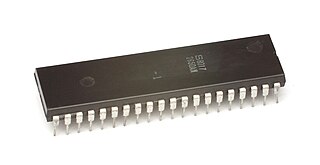
The Signetics 2650 was an 8-bit microprocessor introduced in July 1975. According to Adam Osborne's book An Introduction to Microprocessors Vol 2: Some Real Products, it was "the most minicomputer-like" of the microprocessors available at the time. A combination of missing features and odd memory access limited its appeal, and the system saw little use in the market.

The IntertonVideo Computer 4000 is an early 8-bit ROM cartridge-based second-generation home video game console that was released in Germany, England, France, Spain, Austria, the Netherlands and Australia in 1978 by German hearing aid manufacturer Interton. The console is quite obscure outside Germany, but many software-compatible systems can be found in numerous European countries. The console is the successor of the Interton Video 3001 and was sold for 298 Deutsche Mark and discontinued in 1983.
The Elektor TV Games Computer (TVGC) was a programmable computer system sold by Elektor in kit form from April 1979. It used the Signetics 2650 CPU with the Signetics 2636 PVI for graphics and sound. These were the same chips as used in the Interton VC 4000 console family. A 2K monitor ROM written by Philips and a cassette interface were the most important differences between the TVGC and the Interton family. Many VC 4000 games were adapted versions of TV Games Computer games. It is possible to add cartridge slots to the TVGC to enable it to play console games, and the Hobby Module of the Acetronic console effectively transforms it into a basic TVGC.

The Atari 2600 hardware was based on the MOS Technology 6507 chip, offering a maximum resolution of 160 x 192 pixels (NTSC), 128 colors, 128 bytes of RAM with 4 KB on cartridges. The design experienced many makeovers and revisions during its 14-year production history, from the original "heavy sixer" to the Atari 2600 Jr. at the end. The system also has many controllers and third-party peripherals.
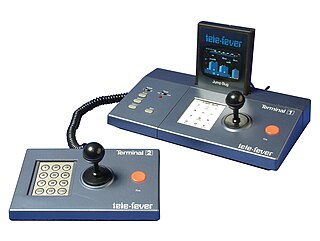
The Tele-Fever is a second-generation home video game console which was released and marketed by German coffee roaster chain Tchibo in 1986 only in Germany for a list price of 99 Deutsche Mark (DM). It is one of the last variants of the Arcadia 2001 home video game console by Emerson Radio and therefore compatible with all software from it.









